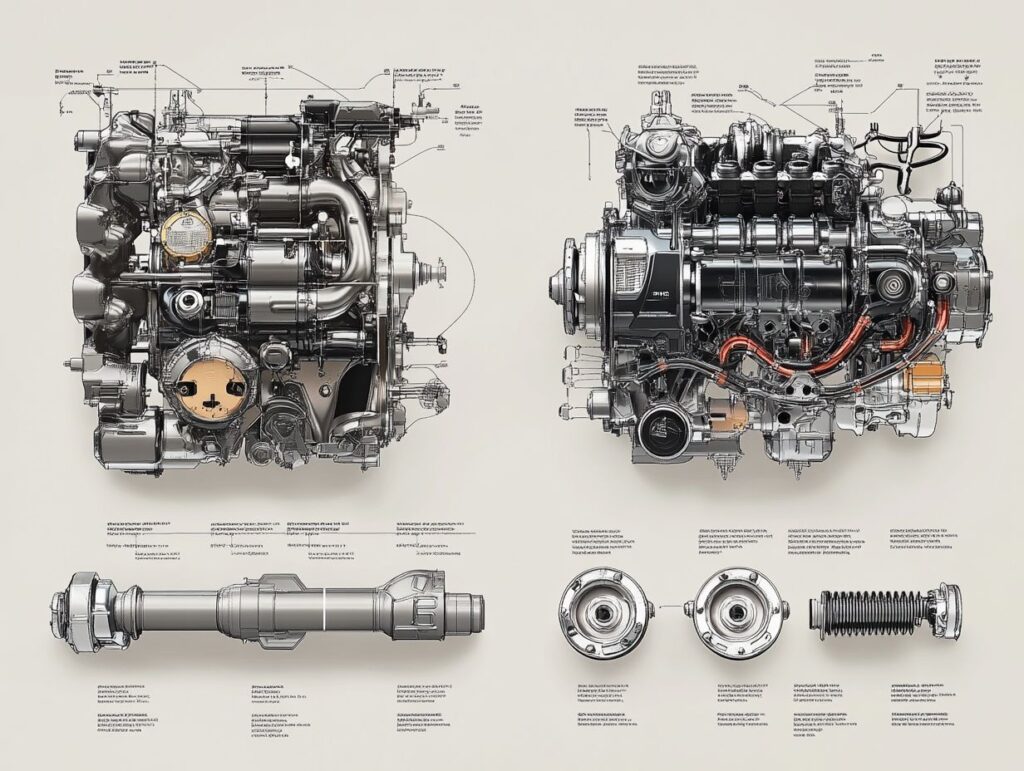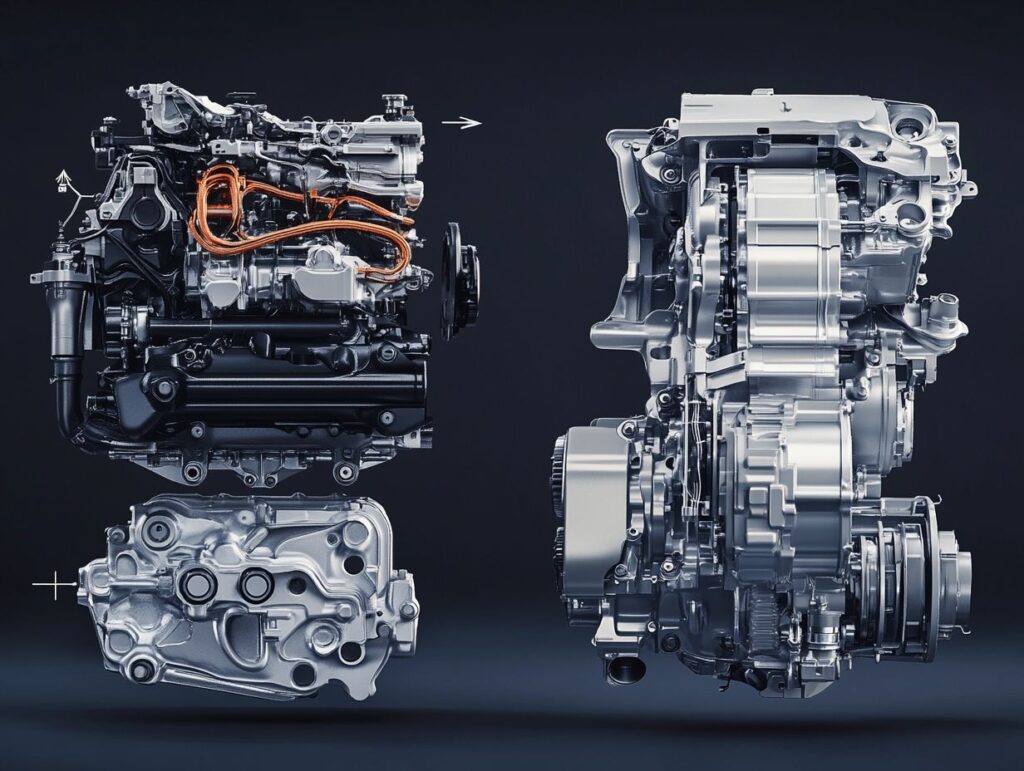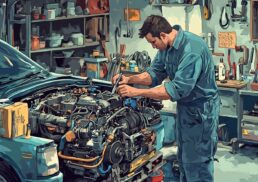When it comes to understanding a vehicle, two components are particularly significant: the engine and the transmission. These essential systems work in concert to power the vehicle and ensure a smooth driving experience. However, many drivers tend to overlook their distinct functions and importance.
This guide will provide an overview of the fundamentals of engines and transmissions, emphasizing their key differences and discussing their roles in performance and maintenance. Readers will gain insight into common issues, necessary repairs, and considerations for selecting the appropriate engine and transmission to meet their specific needs.
This comprehensive overview aims to enhance your knowledge and assist you in making informed decisions regarding your vehicle.
Table of Contents
Understanding Engine and Transmission

A comprehensive understanding of the engine and transmission is essential for any auto mechanic, as these two components are critical to the overall functionality and performance of a vehicle.
The engine, which transforms fuel into mechanical power, operates in conjunction with various types of transmissions to manage power delivery to the drivetrain system. This coordination ensures seamless shifting operations and efficient torque conversion.
A thorough knowledge of the different gearbox types, including manual and automatic transmissions, is necessary for accurately diagnosing engine and transmission issues, thereby enabling mechanics to perform effective vehicle maintenance and repairs.
Basic Functions and Components
The fundamental functions and components of the engine and transmission are critical for comprehending the operation of a vehicle. The engine comprises various elements, including fuel filters, catalytic converters, and the crankshaft, which work collaboratively to convert fuel into usable energy.
In parallel, the transmission consists of essential components such as the gearbox, clutch, and differential, which facilitate the transfer of power from the engine to the wheels, ensuring the vehicle responds effectively to driver inputs.
Each of these components plays a significant role in the overall performance of the vehicle. For example, the engine depends on precise fuel delivery and efficient exhaust management to maintain optimal power output, while the transmission must execute seamless gear shifts to align with the engine’s power curve.
Regular maintenance of these components is essential, as neglecting issues such as worn gears or clogged filters can result in reduced efficiency and potential breakdowns. A comprehensive understanding of how these systems interact offers valuable insights into not only maintaining a vehicle’s smooth operation but also enhancing its long-term reliability and performance.
Differences Between Engine and Transmission

The engine and transmission perform distinct yet interrelated functions within a vehicle.
The engine is responsible for generating power by converting fuel energy into mechanical energy, producing torque at different engine RPMs. Conversely, transmissions, which may be classified into various types such as manual and automatic gearboxes, play a critical role in regulating the application of this power to the wheels.
They ensure that power is delivered efficiently to the drivetrain system, thereby facilitating smooth gear shifts and optimizing overall vehicle performance.
Key Distinctions in Function and Design
The key distinctions in function and design between the engine and transmission highlight their respective roles in vehicle operation. The engine is specifically designed to generate power through combustion processes, while the transmission is engineered to manage that power efficiently, ensuring it is transmitted to the wheels effectively.
This difference in design is critical for performance, as the output of the engine must be carefully aligned with the capabilities of the transmission to achieve seamless operation.
The design of the engine emphasizes the maximization of horsepower and torque through advanced combustion techniques and the utilization of high-performance materials. Conversely, the transmission’s design focuses on optimizing gear ratios and shift timing, which directly impact acceleration and fuel efficiency.
For instance, a well-calibrated transmission facilitates optimal engine performance across various RPM ranges, which is essential for delivering robust torque during acceleration.
Factors such as weight, drag coefficients, and thermal management within both systems collectively influence overall vehicle performance metrics. This interplay between distinct engineering designs underscores how the engine and transmission work in tandem to enhance the driving experience.
Importance of Engine and Transmission in a Vehicle

The significance of the engine and transmission in a vehicle is paramount, as they are essential in determining overall performance, efficiency, and reliability.
A properly functioning engine generates the necessary power to propel the vehicle, while the transmission system ensures that this power is effectively harnessed and transmitted to the wheels.
Regular maintenance focused on these components not only extends the lifespan of the vehicle but also mitigates issues such as engine and transmission failures, which can result in costly repairs and operational downtime.
Impact on Performance and Maintenance
The influence of the engine and transmission on vehicle performance and maintenance is substantial, as these components directly affect the efficiency with which a vehicle operates. An optimized engine not only generates power but also does so with an emphasis on fuel efficiency, while the transmission is essential for effectively utilizing this power.
Proper maintenance of both systems is critical to prevent performance degradation and avoid costly repairs.
Regular monitoring of fluid levels, ensuring timely oil changes, and addressing any unusual noises can significantly extend the lifespan of these essential components. A well-maintained engine contributes to improved acceleration and an enhanced overall driving experience, while a smoothly functioning transmission facilitates seamless gear shifts.
These performance metrics are vital, as they not only enhance driving satisfaction but also decrease the frequency of automotive maintenance, thereby conserving both time and financial resources.
Ultimately, a proactive approach to maintaining these systems can result in a more reliable vehicle, optimized fuel consumption, and reduced emissions.
Common Issues and Repairs for Engine and Transmission

Common issues with the engine and transmission can profoundly impact vehicle performance and safety, underscoring the necessity for auto mechanics to possess proficiency in identifying and repairing these problems.
Engine-related troubles may present symptoms such as poor acceleration, unusual noises, or warning lights illuminated on the dashboard, all of which may indicate potential malfunctions within the engine. Conversely, transmission issues may manifest as slipping gears, delayed shifts, or abnormal sounds, suggesting a malfunction within the transmission system.
Timely intervention through regular vehicle maintenance is crucial to ensure optimal performance and extend the longevity of the vehicle.
Identifying and Addressing Problems
Identifying and addressing issues with the engine and transmission is an essential competency for any automotive technician, as early detection can prevent further damage and minimize costly repairs.
Common indicators of engine malfunction include diminished fuel efficiency, unexpected vibrations, and the illumination of warning lights on the dashboard. Transmission problems may be signaled by irregular shifting, fluid leaks, or slipping gears. A comprehensive understanding of these symptoms enables technicians to perform timely maintenance and repairs.
To accurately diagnose these issues, technicians utilize a variety of diagnostic tools, such as OBD-II scanners, which read error codes from the engine control unit, thereby allowing them to identify specific problems.
Additionally, pressure gauges and fluid analyzers assist in evaluating the performance of both the transmission and engine. Techniques such as visual inspections, auditory assessments for unusual sounds, and conducting road tests further enhance troubleshooting efforts.
By integrating these modern tools and methodologies, technicians can systematically approach repairs, ensuring that both the engine and transmission operate optimally, thereby promoting long-lasting vehicle performance.
Choosing the Right Engine and Transmission for Your Vehicle
Selecting the appropriate engine and transmission for a vehicle is a crucial decision that significantly impacts performance, efficiency, and overall drivability.
When evaluating engine options, it is essential to consider factors such as power output, fuel efficiency, and compatibility with the vehicle’s drivetrain system.
Furthermore, the choice of transmission type, whether a manual or an automatic gearbox, plays a vital role in how the engine’s power is transmitted to the wheels, which in turn affects both performance and maintenance requirements for the vehicle.
Factors to Consider in Selection
When selecting an engine and transmission for a vehicle, several critical factors must be evaluated to ensure optimal performance and compatibility. These factors include the intended use of the vehicle, desired torque delivery, and the overall performance characteristics of both the engine and transmission systems.
A comprehensive understanding of how these elements interact will significantly impact vehicle maintenance and reliability.
Considerations such as the type of driving—whether it involves off-road, daily commuting, or high-performance racing—are vital in this decision-making process. Performance requirements can vary considerably; for example, individuals seeking speed may prioritize lightweight components, while others may require robust systems capable of towing substantial loads.
Potential upgrades, including superchargers or turbochargers for the engine, as well as advanced transmission options, can expand possibilities but may also introduce compatibility challenges. Therefore, it is essential to strike the right balance between power output, durability, and ease of ongoing maintenance to achieve long-term satisfaction with the vehicle.
Learn more, How To Pick the Right Car Transmission for Your Needs?









